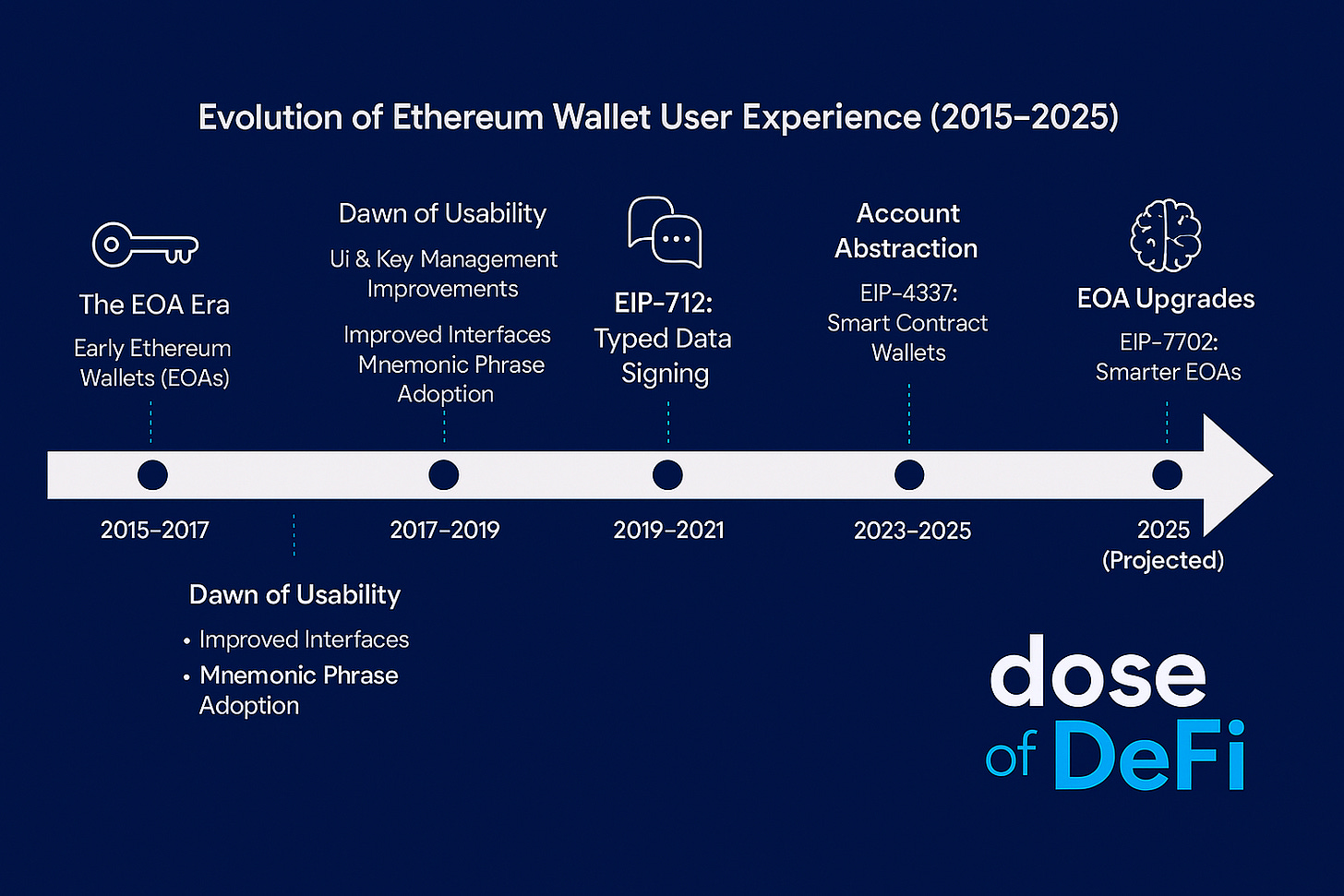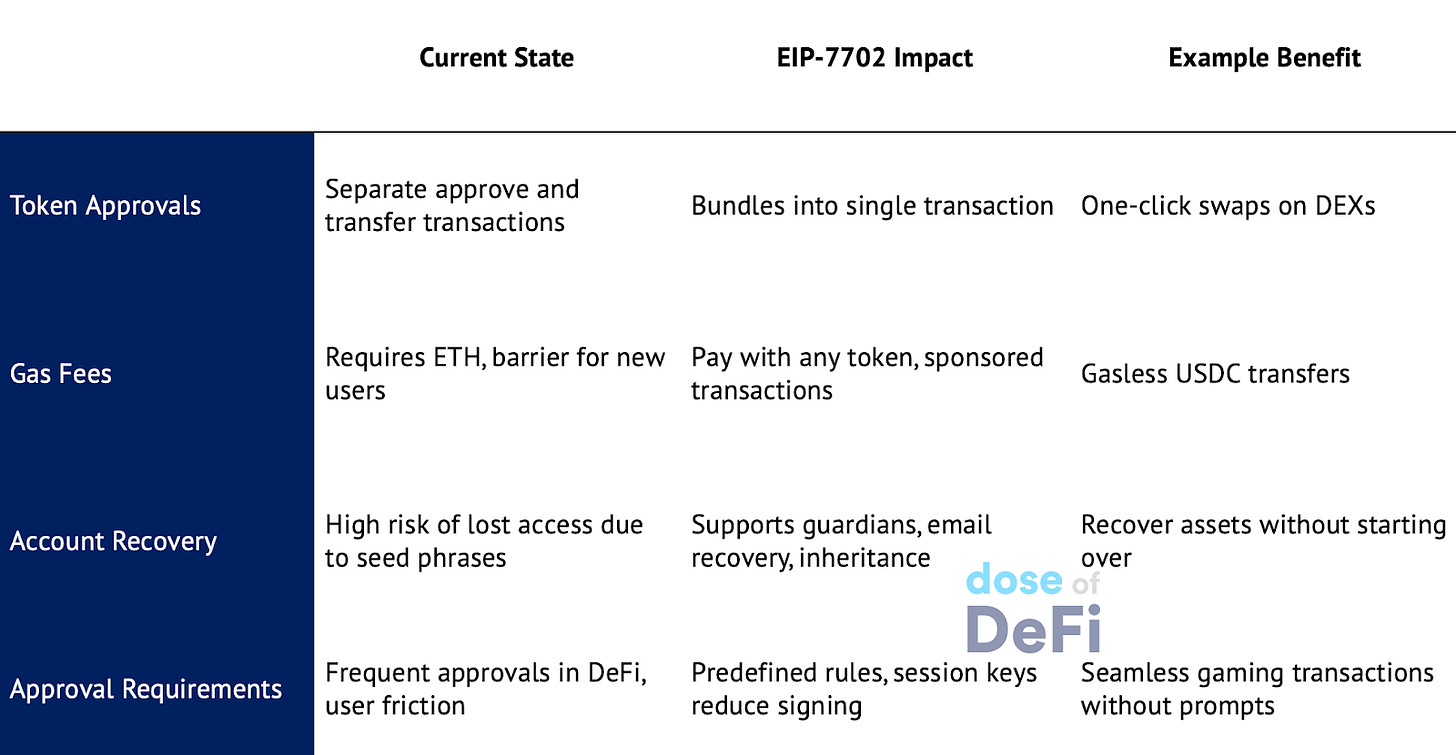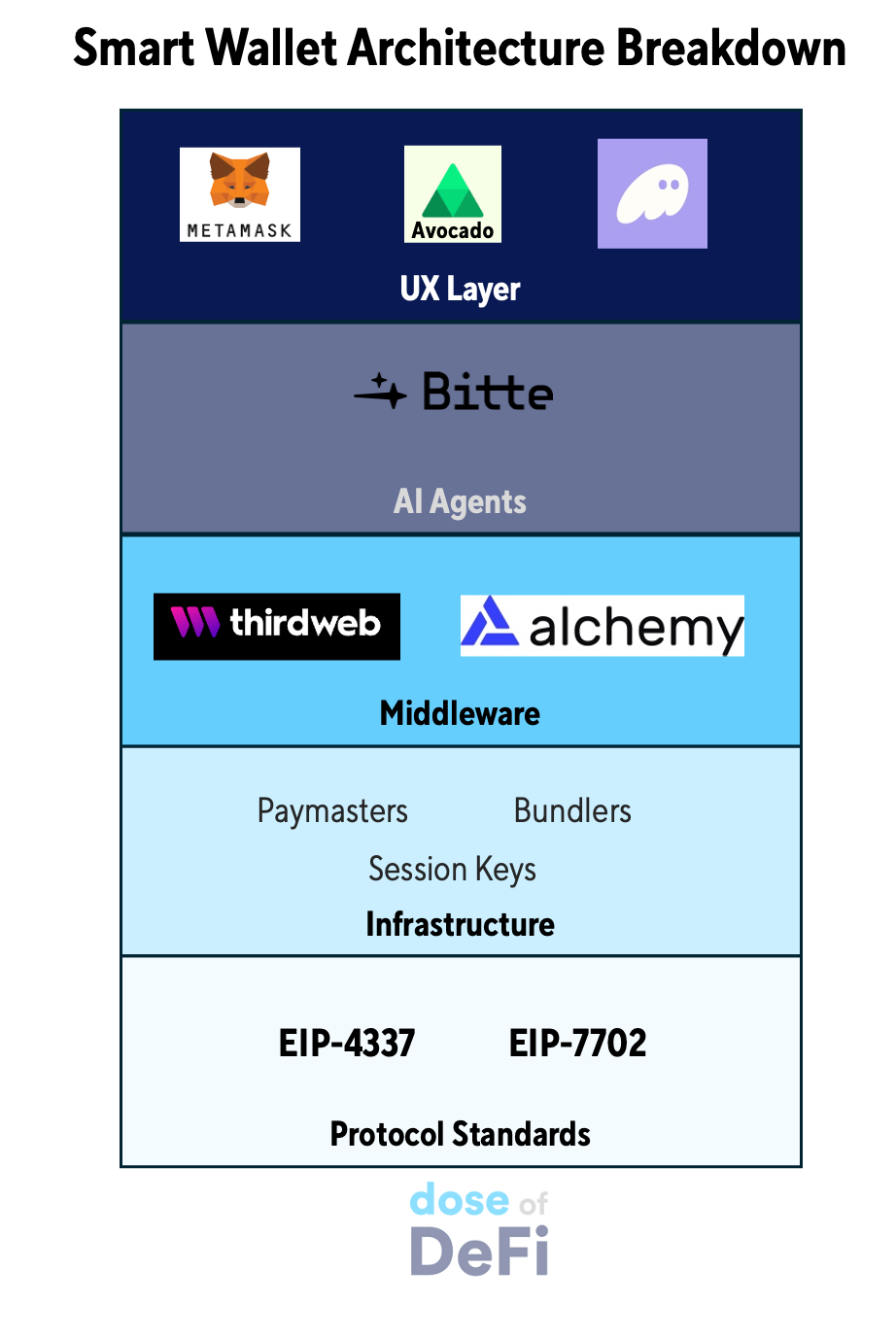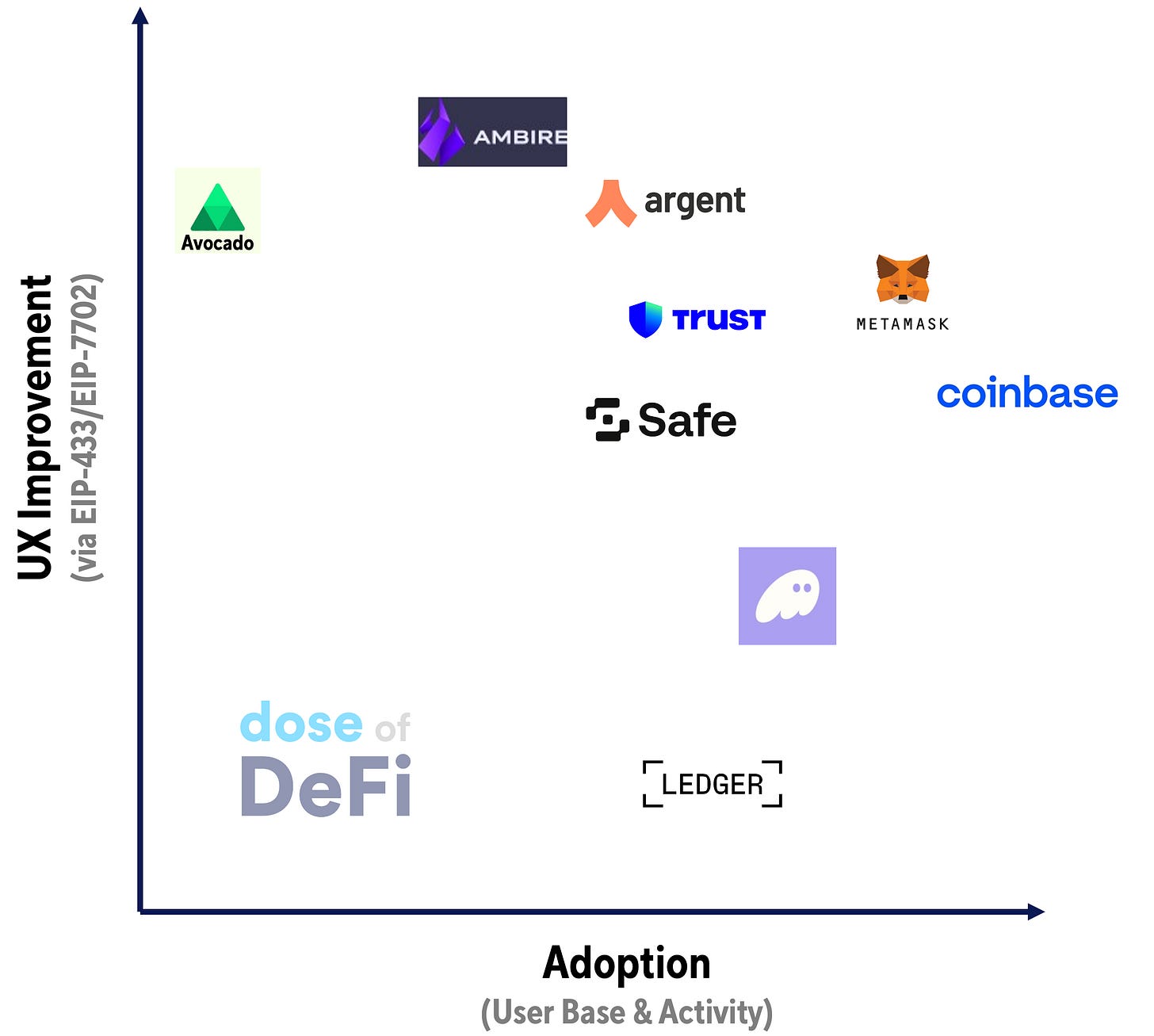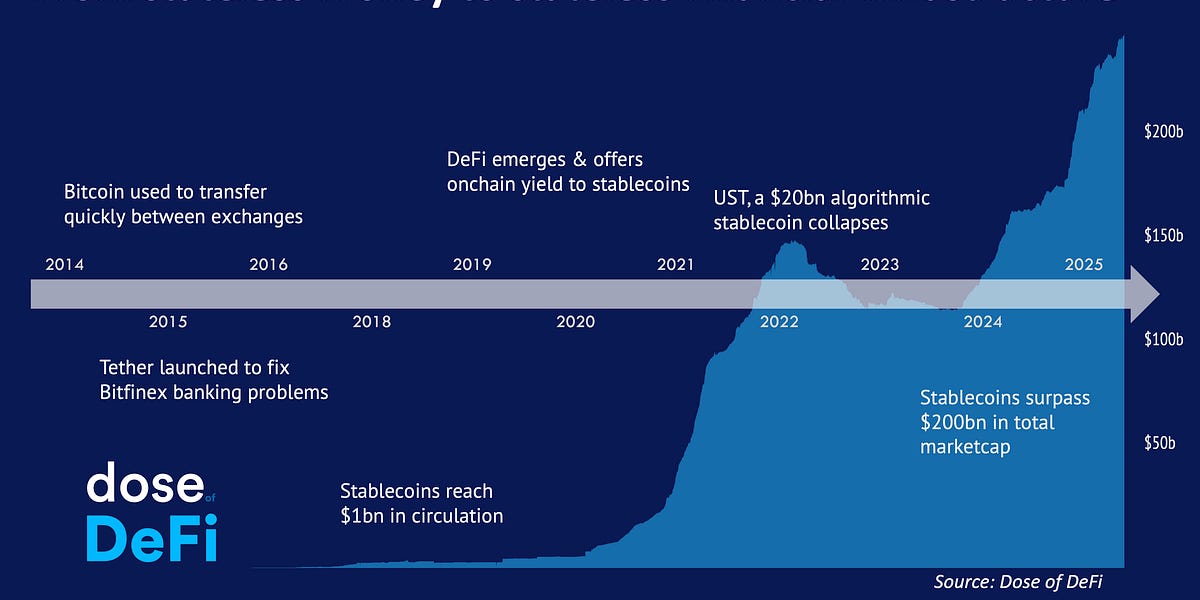Wallets have long been the punching bag of crypto. Their poor UX carries the blame for crypto’s inability to break further into the mainstream. Nobody has a favorite wallet – only the one that annoys them the least. The problem lies with the complexity of blockchains and managing private keys. After years of development, this is slowly changing with the upcoming huge upgrade in the Pectra Hard Fork. Below, Denis & I look at what’s to come, and the implications for market and power structures within a thriving wallet industry.
– Chris
The crypto user experience (UX) has historically been poor, with individuals losing funds, opting for centralized solutions, or leaving the space altogether.
There have been two key efforts to enhance DeFi UX. First, via centralized solutions that offer a white-glove version of DeFi. The DeFi Mullet is a world where onchain protocols are used, but most users rely on centralized services like Coinbase to hold their keys and control their funds (best exemplified by the Coinbase integration of DeFi lending protocol Morpho). The second is via a world that fulfills the original crypto vision, where self-custody is used by the masses and crypto wallets are ubiquitous.
DeFi power users – guilty as charged – are willing to put up with the clunkiness because they want the freedom to explore every inch of the blockchain. But a regular user doesn’t want anything to do with private keys.
Crypto wallets have long disappointed; every cycle promises a better wallet design to finally unlock mainstream adoption. This time, the hype might be warranted. Or at least, it’s a last shot before the centralized services start driving onchain product development.
With the upcoming Pectra Hard Fork on Ethereum (introducing EIP-7702) and fresh revenue models (from in-app swaps to MEV flow deals), wallets are evolving from clunky key-management tools into sophisticated ‘orchestration layers’.
In this piece, we’ll explore how EIP-7702 builds on recent upgrades (i.e. EIP-4337), which wallets are best positioned to capitalize on user-friendly features, and why these changes could finally lead wallet-UX to fulfill its promise of self-custody.
Efforts to enhance UX in crypto have been progressing recently. As discussed in our article titled Abstract away! The race towards interoperability, the latest significant upgrade to Ethereum (EIP-4337) went live in 2024. Now, market attention has shifted to EIP-7702, which is set to launch with the upcoming Pectra Hard Fork. In other words, an opportune moment to discuss its implications. The key one being that, with this new infrastructure in place, we’re finally equipped to build user experiences that can approach Web2 usability – while preserving the core principles of Web3.
EIP-7702 will significantly alter how Ethereum accounts function. Here are some notable improvements that will be made to existing externally owned accounts (EOAs), the default account type:
-
No more token approvals: Approvals and swaps will be bundled into a one-click experience, instead of the clunky current one. Going forward, an EOA can delegate to a smart contract that executes both the approve and transferFrom steps in a single transaction. Bundling also enables more efficient execution of complex DeFi strategies without requiring individual transaction signatures.
-
Gas abstraction: Users will be able to pay gas fees with any token, benefit from sponsored transactions (where an application or wallet covers gas costs), and utilize cross-chain gas payments. Currently, users must acquire ETH or SOL to send USDC – imagine having to buy Federal Reserve stock just to wire dollars.
-
Account recovery: Depending on the wallet provider, recovery options such as guardians, email-based recovery, and legacy/inheritance features will be introduced. Many crypto users have lost tokens by misplacing their seed phrases.
-
Less signing: Users will be able to set predefined rules for interacting with decentralized applications, providing limited access without requiring constant approvals. With EIP-7702, users can create session keys to help mitigate the associated friction by allowing users to pre-authorize interactions, reducing the need for excessive signing.
Despite the benefits, the speed at which EIP-7702-based wallets will be adopted is uncertain. One thing about wallets is that users are sticky – and products are slow to implement new features. For Dapps, this creates twice the complexity: two user journeys, two separate interfaces – almost like building two distinct products. As a result, there’s little immediate motivation for Dapps to invest in dedicated account abstraction experiences, and users have little reason to adopt smart accounts if they don’t noticeably improve their Web3 experience.
Ambire, Argent and Avocado are among the first wallets to add EIP-4337-based smart contracts. In the developer tools space, Thirdweb and Alchemy offer SDKs and APIs that make it easy for developers to embed EIP-4337-compliant smart wallets into dApps, accelerating adoption.
In 2024, EIP-4337 smart accounts saw massive growth, with over 103 million User Operations – a more than tenfold increase from 2023. (Side note: UserOps are a new user transaction type after the EIP-4337 update). However, most accounts were single-use, driven by apps offering sign-up rewards, while only a few apps, like Blocklords and OpenSocial, succeeded in driving repeat engagement. Notably, 87% of UserOps fees were covered by Paymasters, making transactions cheaper for users. Overall, EIP-4337 adoption expanded across multiple chains and use cases, especially gaming and social apps (though retaining active users remains a challenge). Still, ERC-4337 bundle transactions represented only about 1.5% of total ETH + L2 ecosystem transactions in 2024.
One critical aspect missing from the wallet-UX-upgrade movement is privacy. Vitalik Buterin recently emphasized that privacy remains an unresolved issue in crypto. Privacy-focused cryptocurrency Monero, despite its talented developer team and significant financial resources, has never achieved mainstream adoption. While the removal of Tornado Cash from the OFAC sanctions list is a positive development, the blockchain community – including the Ethereum Foundation – has yet to prioritize privacy enhancements at the Layer 1 level. In his December article, Vitalik poses some short-term privacy solutions based on wallets, some of which are being implemented in Zupass. However, to have a proper long-term solution, these improvements need to be implemented at the base chain or application layer, like the recent launch of PrivacyPools.com.
Outside of the infrastructure improvements, wallets may also see improvements with the rise of AI. Bitte.ai is pioneering AI-driven automation by embedding AI agents directly into DeFi applications. Instead of traditional point-and-click interfaces, Bitte’s system employs chat-based interactions, where AI assistants guide users, execute transactions, and manage DeFi activities.
Projects such as Bitte allow users to input natural language commands (e.g., “Swap X ETH for X USDC on chain X,” “Deposit to Spark,” “Send 0.5 ETH to Mom”). AI then determines the optimal route, constructs the transaction, and presents it for confirmation. This text-based approach improves usability by consolidating multiple DeFi protocols within a single interface. To enhance security, AI analyzes user behavior and introduces additional confirmation steps for suspicious activity.
One of the greatest benefits of the shift to AI-driven or chat-based UX is the rise of intent protocols. As we previously discussed, intents represent a user expressing their desired outcome in a transaction request. This approach removes unnecessary constraints on how the request is executed, focusing instead on the intended result. Specialized actors known as ‘solvers’ then compete to identify the most cost-efficient way to fulfill a user’s intent.
So to recap, wallets will benefit from major infrastructure upgrades on Ethereum with 7702. And with this, be able to wield AI in their never-ending battle to abstract away the complexity of blockchain transactions.
For most of crypto’s history, wallets were critical infrastructure with no business model. They sat closest to the user but struggled to capture value, serving as UI layers that were expensive to build and maintain, yet difficult to monetize. That’s now changed. Today, wallets are quietly becoming profitable. MetaMask generates $50 million+ through in-app swaps. Phantom just raised at a $3 billion valuation with a reported $90 million in annualized revenue. Many wallets now monetize order flow or capture MEV — similar to how Robinhood monetizes retail flow in traditional finance.
Wallets have always been alluring to investors, but never sustained the investment required to make them consumer products. With a more predictable revenue stream, investors and companies will surely be more willing to dump resources into marketing and user acquisition for wallets.
These changes carry major business implications. Today, users must manually select a blockchain, adding unnecessary complexity. In the future, intermediaries will automate this process based on security preferences (e.g., institutional investors favoring highly secure chains) or specific user goals (e.g., choosing a chain that supports a particular DeFi protocol).
Entities that implement this selection – such as wallets and intent protocols – could become the dominant distribution channels, effectively controlling the user relationship. This shift would benefit risk managers like Gauntlet and Block Analitica, as well as risk assessment frameworks like L2Beat. This would then influence which chains and protocols AI defaults to as ‘preferred’ options. By default, assets may be allocated to safer networks such as Ethereum or Stage 1 L2s like Arbitrum and OP (as categorized by L2Beat), while advanced users could opt for riskier alternatives, including Stage 0 L2s.
However, this trend could face pushback from L1 and L2 chains, as it risks commoditizing them. L1s and L2s are among the most well-funded and deeply entrenched players in the industry, making the competitive dynamics unpredictable. Uniswap has already launched its own blockchain and later introduced a wallet, so is likely to maintain control over its user relationship. Meanwhile, we see ‘Ethereum-aligned’ wallets like MetaMask directing traffic toward Ethereum and its L2s. Yet as MetaMask adapts to market demand by integrating Solana, one must ask: will the Ethereum Foundation need to launch its own ‘Ethereum Wallet’ to defend its moat?
Wallets now have the upgrades, business models, and AI-driven UX to push DeFi towards the mainstream. Still, there’s no guarantee of a purely self-custodial future.
On one hand, the DeFi Mullet isn’t likely to go anywhere: centralized platforms already dominate onboarding and can simply fold in onchain back-ends for those wanting ‘crypto under the hood’ without key-management hassles. On the other, EIP-7702 and ‘wallet-as-orchestrator’ models give self-custody its best shot yet. If wallet providers pair account abstraction, AI-driven interfaces, and new revenue streams (like MEV flow deals) to fund innovation, they could finally overcome the clunky UX that has deterred everyday users.
We have good reason to want self-custodial wallets to succeed. They uphold crypto’s founding principle of decentralization and prevent lock-in. If widely adopted, user-controlled wallets would mean no single platform can hold funds hostage or dictate the rules.
Whether these paths merge, coexist, or collide is still to be seen – and the deciding factors go well beyond user interfaces. As we explored in DeFi splits in two in the fall, regulations, liquidity fragmentation, and protocol governance also push DeFi in divergent directions. In the near term, we may see the DeFi Mullet thrive with newcomers seeking simplicity, while more advanced or privacy-conscious users embrace the new wave of powerful, user-friendly self-custody.
If that latter group can deliver a ‘just works’ experience to rival centralized apps, they may fulfill crypto’s original vision. But if key-management complexities remain unsolved, custodial giants will remain the face of DeFi. One way or another, wallets are now best positioned to decide which version of ‘financial freedom’ wins out – and how decentralized the future of DeFi will be.
-
Aave integrates Chainlink SVR on Ethereum for liquidation MEV recapture Link
-
CowAMM suffers small exploit exploit Link
-
Rath Finance launches new DeFi rails for yield packaging Link
-
Hydro team develops new approach to impermanent loss Link
-
Compound Labs reemerges, toys with launching Compound Foundation Link
-
DeFi revenues decline in March as onchain activity slows Link
-
AtlasEVM introduces universal auction system for transaction execution Link
-
Matcha expands to Solana with SVM and EVM chain support Link
That’s it! Feedback appreciated. Just hit reply. Still into this meme: open-source capitalism.
Dose of DeFi is written by Chris Powers, with help from Denis Suslov, Zhev and Financial Content Lab. All content is for informational purposes and is not intended as investment advice.


